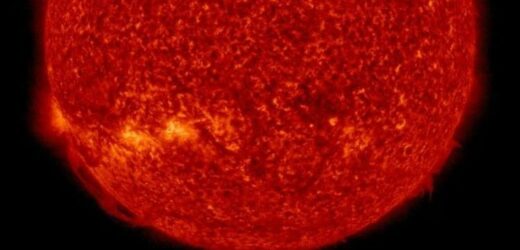Earth’s ‘magnetic song’ captured during solar storm
We use your sign-up to provide content in ways you’ve consented to and to improve our understanding of you. This may include adverts from us and 3rd parties based on our understanding. You can unsubscribe at any time. More info
A coronal mass ejection (CME) of plasma and magnetic field has escaped the Sun and is forecast to possibly strike later this week. The CME was cast towards the planet on Monday when a large filament of magnetism lashed out from the Sun’s bottom half. According to the US Space Weather Prediction Center (SWPC), CMEs can escape the Sun at speeds between 560,000mph to more than 6.7 million mph.
At these breakneck speeds, the fastest CMEs can reach our planet in as little as 15 to 18 hours.
The SWPC said: “Slower CMEs can take several days to arrive.
“They expand in size as they propagate away from the Sun and larger CMEs can reach a size comprising nearly a quarter of the space between Earth and the Sun by the time it reaches our planet.”
According to the astronomers behind SpaceWeather.com, Monday’s CME is predicted to possibly strike on Friday.


But instead of a direct hit, astronomers predict the CME could land a glancing blow to the planet’s magnetosphere – the region of space dominated by Earth’s magnetic field.
If the CME does strike, it may lead to some minor geomagnetic unrest (solar storms) around the planet.
Space Weather said: “Minor geomagnetic storms are possible on December 3 when a CME might sideswipe Earth’s magnetic field.
“The storm cloud was hurled into space on November 29 by an erupting filament on magnetism in the Sun’s southern hemisphere.
Solar storm: NASA captures the moment a sunspot 'explodes'
“According to NOAA computer models, the bulk of the CME should sail south of our planet with a near miss just as likely as a glancing blow.”
The more powerful a CME is, the stronger the geomagnetic storms felt around the planet.
Scientists rank these storms on a scale of “G1 Minor” to “G5 Extreme”.
The SWPC explained: “A geomagnetic storm is a major disturbance of Earth’s magnetosphere that occurs when there is a very efficient exchange of energy from the solar wind into the space environment surrounding Earth.


“These storms result from variations in the solar wind that produces major changes in the currents, plasmas, and fields in Earth’s magnetosphere.”
A Minor solar storm is fairly inconsequential though it can lead to weak power grid fluctuations and mess with satellite operations.
The most visible effect is the appearance of auroras in the polar circles – Aurora Borealis in the north and Aurora Australis in the south.
At the other end of the scale, Extreme storms are very dangerous and cause entire power grids to collapse, trigger communication loss and cause auroras to appear as far south as Texas and Florida.
As of Wednesday evening, the SWPC’s three-day forecast does not expect any geomagnetic unrest around the Earth.
The forecasters wrote: “No G1 (Minor) or greater geomagnetic storms are expected.
“No significant transient or recurrent solar wind features are forecast.”
They added: “No R1 (Minor) or greater radio blackouts are expected.
“No significant active region flare activity is forecast.”
Source: Read Full Article

